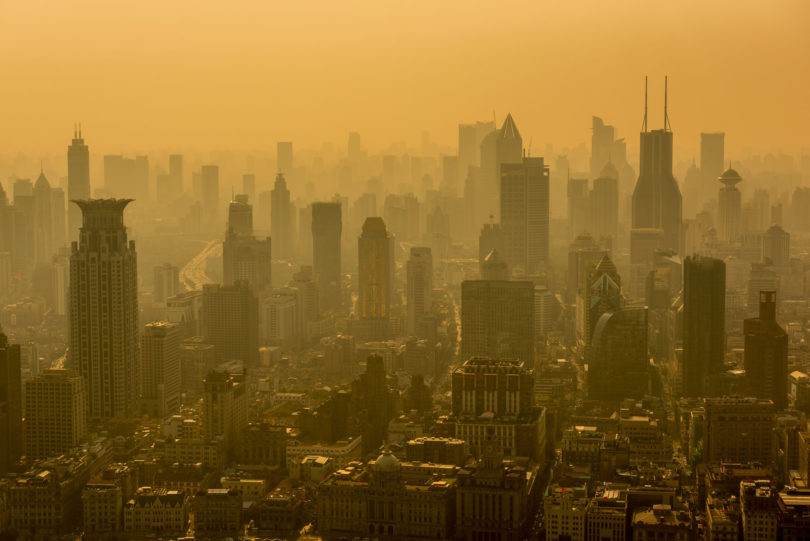Most of us don’t think twice about breathing. In fact, the average adult takes around 20,000 breaths per day. It’s a natural process of moving air into and out of the lungs — breathing in oxygen and flushing out carbon dioxide. But what do we do when that simple act of breathing becomes harmful? According to the World Health Organization (WHO), air pollution accounts for an estimated 4.2 million premature deaths per year due to stroke, heart disease, lung cancer and chronic respiratory diseases.
While that’s hard to imagine, especially if you live in an area without smog, smoke or excess traffic, about 91 percent of the Earth’s population lives in places with worse air quality than the standards set by the WHO.
When it comes to air pollution, there are two major contributors — fine particles and ozone; these are the things that when inhaled are detrimental to your health,” says Jim Crawford, an atmospheric chemist at NASA’s Langley Research Center.
What Causes Air Pollution?
Air pollution is a general term that usually describes a mixture of different harmful chemicals that circulate in the air. Pollutants can be natural — such as ash from a volcano or smoke from a wildfire — or man-made. Examples of man-made pollutants include carbon dioxide output from vehicles, factories and the burning of fossil fuels.
The warming of the earth has also had an effect on the air we breathe. The Centers for Disease Control (CDC) reports that higher temperatures lead to an increase in allergens and harmful air pollutants. For instance, longer warm seasons can mean longer pollen seasons — which can increase the risk of allergy attacks and cause more allergies.
Higher temperatures can also lead to an increase in ozone, a harmful air pollutant. While good ozone occurs naturally in the upper atmosphere and protects living things from ultraviolet radiation, “bad” or ground-level ozone, which is created by chemical reactions in the sunlight, can trigger a variety of health problems. Though bad ozone is colorless and odorless, when enough builds up, it results in smog.
Higher temperatures also mean drier conditions, particularly in the western part of the country, which in turn spurn more wildfires.
Wildfires release large amounts of carbon dioxide, black carbon, brown carbon and ozone precursors into the atmosphere. A 2013 report released by scientists for Climate Central, which researches climate science, found that smoke and ash produced by large wildfires threaten the health of thousands of people, often hundreds of miles away from where these wildfires burn.
“Not only do wildfires threaten lives directly, but they have the potential to increase air pollution and affect those with respiratory issues,” says Patrick Taylor, a research scientist at NASA Langley. “Wildfires don’t have to be close to you to affect your air quality — smoke and particulate can travel long distances.”
The Effects of Air Pollution
Hundreds of studies have confirmed that long-term exposure to air pollution can be linked to asthma, lung diseases, heart attacks and even cancer. When people breathe in air pollutants, the microscopic particles travel down the throat to the lungs, penetrating deep into our respiratory and circulatory systems. Over time, the constant irritation results in serious medical conditions, especially to those who already have compromised immune systems.
While many may think only those who live in the more heavily polluted cities and countries are at risk, air pollution can often travel great distances to smaller rural areas and knows no socio-economic boundaries.
“Ground-level ozone and airborne particles are the two criteria pollutants that pose the greatest threat to human health in this country,” confirms a spokesperson from the Environmental Protection Agency (EPA).
Though nationally the EPA reports that concentrations of air pollutants have dropped significantly since 1990, health concerns are still on the rise. In fact, researchers are still learning how air pollution affects humans over time.
A recent study in China found that breathing unsafe air for too long can create an effect that’s equal to losing a year’s worth of intelligence. According to the research, those who are consistently exposed to polluted air can experience a large drop in language and math scores.
Similarly, a study out of the United Kingdom suggests that air pollution can potentially raise dementia risks by 40 percent. In 2017, a similar study in Canada found that those living closer to highways or major roads had a 4 percent increased risk of developing dementia.
How to Protect Yourself
While government agencies work to reduce and control the amount of toxic air pollutants we breathe, the EPA suggests these ways you can protect yourself and limit your exposure.
- Check your local air quality reports. The EPA’s Air Quality Index (Airnow.gov) tool will alert the public quickly when air quality is likely to reach unhealthy levels.
- During higher-pollution periods, exercise and work outdoors early in the morning, when pollution levels are usually lower.
- High-traffic areas are more polluted; avoid them when on foot or bicycling.
- Don’t burn trash or wood outside or leave your car idling. On high-pollution days, don’t run fuel-burning power equipment.
- Don’t assume face masks are going to solve the problem. N-95 masks may provide some benefit, but most commercially available air masks are not designed to protect against all forms of air pollution, like smog.







